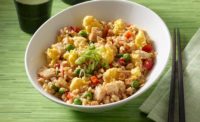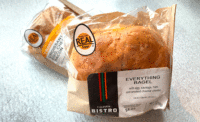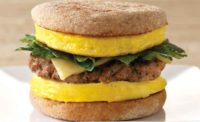American Egg Board: Incredible and Inevitable
Eggs are embraced by consumers and formulators alike and play a much more prominent and significant role in many snack formulations

Snacking a bit more lately? You’re not alone. While snacking as an overall trend has been on the rise for the past few years, nationwide snacking is surging.
According to an online survey conducted by the International Food Information Council (IFIC) in April of this year, the events of 2020 have had a dramatic impact on our eating habits. In this survey, 85% of respondents have made changes in their dietary habits, and of those, 32% say they are snacking more and thinking about food more than usual (27%). Stress eating related to snacking appears more prevalent in families. When these figures are broken into parents vs. non-parents, 41% of parents are snacking more as a result of coronavirus compared to 29% of non-parents.
Even though eggs long ago broke the mold of faithful breakfast companion to expand their repertoire, eggs weren’t traditionally a part of snack food formulating, except in the indulgent category—think ice cream and baked goods. According to IRI data, true indulgence still drives the most growth in snacks, but all segments are getting a share of consumer wallets, including wellness (such as bars) and permissible indulgence. Eggs are being embraced by consumers and formulators alike. They play a much more prominent and significant role in many snack formulations. Moreover, they even act as the hero in what were formerly unlikely application scenarios for eggs.
Simply … an Egg
Within the past couple of years, a number of novel entrants to the snack market have cast eggs in the starring role. Peckish might have been the first to highlight the humble hard-boiled egg as a snack option, hailed for its protein content, familiarity and comfortable alliance with any manner of spices presented as a dip or dust to amp up the flavor. Eggs supply the nutrition and protein while the dips and dusts provide an adventure for the tastebuds.
Even more unlikely, picture the egg as a snack chip. Quevos keto-friendly egg chips rely on egg white, again acting as a blank canvas to carry flavor forward spice blends, such as dill pickle. It ticks all the boxes for high protein, low carbs, gluten-free, keto-friendly, shelf-stable snack option. Lesser Evil® presents egg white in a puffed or extruded curled form (picture a cheese curl) for a gluten-free, grain-free crunchy and definitely nontraditional form of the egg white.
A Bar for Every Occasion
One surprising yet logical transformation of egg ingredients is their use in snack bars. Bars have come a long way in a relatively short period of time, with varieties that make the original granola bar, introduced in the 1970s, look like something akin to a dinosaur. Today, bars account for a $6.4 billion market. (IRI data) https://www.snackandbakery.com/articles/94833-state-of-the-industry-2020-health-and-flavor-lead-the-way-in-bars
There are literally dozens of choices among energy/snack bars, if not more. Front of package claims such as protein callouts, calorie count and even diet plan alignment (i.e., keto- and paleo-friendly) help consumers sift through their options, and more often than not, the egg’s nutritional profile dovetails perfectly with these claims. More than half of all consumers (54%) look for snacks that contain vitamins and minerals, and bars often fit the bill. Consumers also equate protein with energy, making protein a focus of bars and other snack food choices. Another benefit? Bars are convenient, easy to grab and go (even when quarantine rules inhibit the “go” portion), and bars are shelf-stable.
As a few examples, The Fbomb® line of bars includes whole egg and advertises a “free-from” energy boost with its concentration on clean, natural ingredients that fit within both keto and paleo diet trends.
The RXBar® line focuses on its short list of natural ingredients and minimalist formulating for a high-protein bar that prominently features egg whites, includes nuts for texture and often fruit, such as dates for binding. The latest addition of a layered bar to the RxBar® lineup features 14 to 15 grams of protein per bar.
Speaking fluent paleo-friendly lingo, Epic™ bars combine various animal proteins, such as beef, chicken or turkey, with egg yolk and dried fruits, vegetables, nuts or seeds. A variety of “creative spice blends” complement the mixture and the final product delivers a heavy protein load and “epic” taste.
Permissible Indulgence
Another area of snacking seeing a rise in sales are permissible indulgent treats in various forms.
The indulgence is supplied by the flavors and ingredients, such as chocolate or premium fruit blends, while the permissible portion is usually communicated through reduced sugar, low carbs or dietary plan alignment, such as keto- or paleo-compatible snacks.
One example is a low-carb white chocolate macadamia cookie from ChipMonk Baking. White chocolate and macadamia nuts supply the indulgence, without added sugar or artificial sweeteners, and just two grams net carbs, with eggs holding a prominent position on the ingredient list.
Snacking One Bite at a Time
In keeping with a low-carb lifestyle that turns to snacking for fuel and fun, more than one manufacturer has introduced egg bites in the frozen or refrigerated section. Eggs are often prepared sous vide, for a velvety texture that pairs easily with cheeses, vegetables or other proteins, such as bacon. The refrigerated and frozen forms are easy to heat for a quick, nutritious, tasty and filling snack or mini-meal, often in finger food form.
Finally, whether considered main meal or snack food, eggs now help hold up their end of functionality and nutritional content in low-carb, gluten-free and nontraditional pizza crusts, helping bind together the veggies that make up a Caulipower pizza crust.
This short representation barely skims the surface of the many ways eggs can add function and flavor to snack items. Egg products contribute binding, richness, emulsification, leavening and much more to help launch successful snack products that can capture a share of this burgeoning market.
Turning to Eggs
Eggs are an all-natural, nutrient-rich source of high-quality protein. Each large egg supplies six grams of bioavailable protein and is a good or excellent source of eight essential nutrients, including choline and lutein – all for just 70 calories. Within the last few years, formulators are taking advantage of the egg’s nutritional profile to help boost label claims. Eggs are keto- and paleo-friendly and can help with creating low-carb and gluten-free snacks and foods.
One additional reason consumers turn to whole, hard-boiled eggs as a standalone snack or salad companion is not just their nutritional profile, but the satiating nature of an egg to help a person feel full longer. A filling snack food and a multifunctional ingredient workhorse—eggs are a tasty, nutritional addition to snack food formulations.
Elisa Maloberti is director of egg product marketing at the American Egg Board.
About the American Egg Board (AEB)
Home of the Incredible Egg, the AEB is the U.S. egg industry’s national commodity marketing board. The AEB’s mission is to increase demand for eggs and egg products through research, education and promotion. The AEB’s Egg Nutrition Center is the science and education division of the AEB. The AEB is located in Chicago.
www.aeb.org
Looking for a reprint of this article?
From high-res PDFs to custom plaques, order your copy today!






